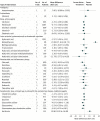Association of Pharmacological Treatments With Long-term Pain Control in Patients With Knee Osteoarthritis: A Systematic Review and Meta-analysis
- PMID: 30575881
- PMCID: PMC6583519
- DOI: 10.1001/jama.2018.19319
Association of Pharmacological Treatments With Long-term Pain Control in Patients With Knee Osteoarthritis: A Systematic Review and Meta-analysis
Abstract
Importance: Even though osteoarthritis is a chronic and progressive disease, pharmacological agents are mainly studied over short-term periods, resulting in unclear recommendations for long-term disease management.
Objective: To search, review, and analyze long-term (≥12 months) outcomes (symptoms, joint structure) from randomized clinical trials (RCTs) of medications for knee osteoarthritis.
Data sources and study selection: The databases of MEDLINE, Scopus, EMBASE, Web of Science, and the Cochrane Central Register of Controlled Trials were searched until June 30, 2018 (MEDLINE alerts through August 31, 2018) for RCTs of patients with knee osteoarthritis that had treatment and follow-up lasting 1 year or longer.
Data extraction and synthesis: Data at baseline and at the longest available treatment and follow-up of 12 months' duration or longer (or the change from baseline) were extracted. A Bayesian random-effects network meta-analysis was performed.
Main outcomes and measures: The primary outcome was the mean change from baseline in knee pain. Secondary outcomes were physical function and joint structure (the latter was measured radiologically as joint space narrowing). Standardized mean differences (SMDs) and mean differences with 95% credibility intervals (95% CrIs) were calculated. Findings were interpreted as associations when the 95% CrIs excluded the null value.
Results: Forty-seven RCTs (22 037 patients; mean age range, mostly 55-70 years; and a higher mean proportion of women than men, around 70%) included the following medication categories: analgesics; antioxidants; bone-acting agents such as bisphosphonates and strontium ranelate; nonsteroidal anti-inflammatory drugs; intra-articular injection medications such as hyaluronic acid and corticosteroids; symptomatic slow-acting drugs in osteoarthritis such as glucosamine and chondroitin sulfate; and putative disease-modifying agents such as cindunistat and sprifermin. Thirty-one interventions were studied for pain, 13 for physical function, and 16 for joint structure. Trial duration ranged from 1 to 4 years. Associations with decreases in pain were found for the nonsteroidal anti-inflammatory drug celecoxib (SMD, -0.18 [95% CrI, -0.35 to -0.01]) and the symptomatic slow-acting drug in osteoarthritis glucosamine sulfate (SMD, -0.29 [95% CrI, -0.49 to -0.09]), but there was large uncertainty for all estimates vs placebo. The association with pain improvement remained significant only for glucosamine sulfate when data were analyzed using the mean difference on a scale from 0 to 100 and when trials at high risk of bias were excluded. Associations with improvement in joint space narrowing were found for glucosamine sulfate (SMD, -0.42 [95% CrI, -0.65 to -0.19]), chondroitin sulfate (SMD, -0.20 [95% CrI, -0.31 to -0.07]), and strontium ranelate (SMD, -0.20 [95% CrI, -0.36 to -0.05]).
Conclusions and relevance: In this systematic review and network meta-analysis of studies of patients with knee osteoarthritis and at least 12 months of follow-up, there was uncertainty around the estimates of effect size for change in pain for all comparisons with placebo. Larger RCTs are needed to resolve the uncertainty around efficacy of medications for knee osteoarthritis.
Conflict of interest statement
Figures




References
-
- GBD 2015 Disease and Injury Incidence and Prevalence Collaborators Global, regional, and national incidence, prevalence, and years lived with disability for 310 diseases and injuries, 1990-2015: a systematic analysis for the Global Burden of Disease Study 2015. Lancet. 2016;388(10053):1545-1602. doi:10.1016/S0140-6736(16)31678-6 - DOI - PMC - PubMed
-
- Hochberg MC, Altman RD, April KT, et al. ; American College of Rheumatology . American College of Rheumatology 2012 recommendations for the use of nonpharmacologic and pharmacologic therapies in osteoarthritis of the hand, hip, and knee. Arthritis Care Res (Hoboken). 2012;64(4):465-474. doi:10.1002/acr.21596 - DOI - PubMed

